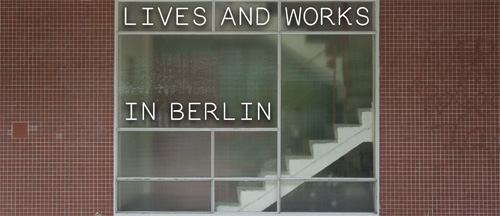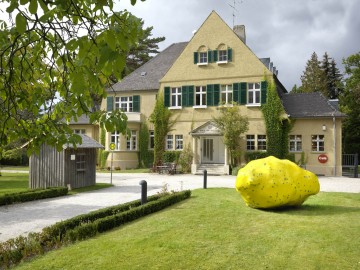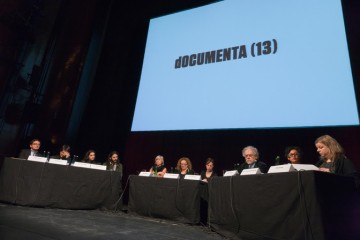Bundle up, Berlin: winter is almost here, and it might be a long one, again. If you haven’t fallen prey to the sniffling, the sneezing, the nose-blowing and coughing, germ-spreading crowd on the city’s subways and got stuck in bed with the first cold flu of the season (like me), there are some interesting exhibitions going on that make it worth the effort of getting out there.
There is, for example, Dutch artist Willem de Rooij’s project Intolerance at the Neue Nationalgalerie, which consists of a site-specific, temporary installation as well as a three-part publication. In the installation, de Rooij presents a group of 17th-century Dutch bird paintings by Melchior d’Hondecoeter, who exclusively painted birds, with a group of Hawaiian “feathered heads” from the 18th and 19th centuries.
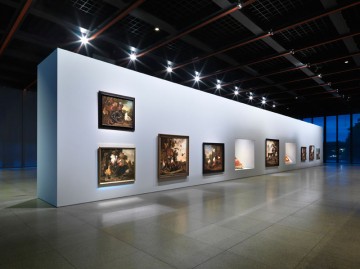
Willem de Rooij, "Intolerance," 2010. Installation at Neue Nationalgalerie, detail view with hawaiian feather objects and paintings by Melchior d‘Hondecoeter © Staatliche Museen zu Berlin. Photo: Jens Ziehe.
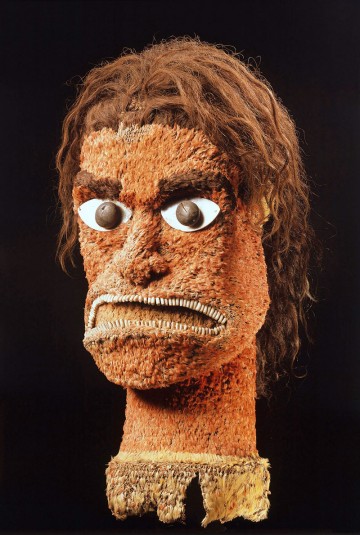
Willem de Rooij, "Intolerance," 2010. "Symbol of the War God Kukailimoku," Hawaii, 18th century. Collection of James Cook, Ethnologisches Museum, Staatliche Museen zu Berlin © Staatliche Museen zu Berlin. Photo: Claudia Obrocki.
De Rooij’s works investigates notions of image-production and image-distribution through playing with conventions of presentation and representation in various media such as photography, film, sculpture and text. In this way, his work opens up a large amount of possible interpretations and so, according to the press release, “Intolerance can be read as a three-dimensional collage, as a reflection on the conditions of the exhibition space and of institutional practice, and as a visual study on the triangular relationship between early global trade, inter-cultural conflict and mutual attraction.” Intolerance will be on display at the New National Gallery until January 2, 2011.
Opening this week, Carsten Höller’s SOMA at the Hamburger Bahnhof poses questions about the relationship of science and myth, the experience of consciousness, and the achievement of enlightenment. Even though the word Soma is today widely used for everything from women’s lingerie and spa treatments to bicycle frames and gourmet chocolate, Höller explores the term in a very specific context: Soma was a drink known among Verdic nomads in North India in the 2nd millennium BCE that was said to have healing properties. The consumption of this drink promised enlightenment and access to the divine sphere and was commonly used in rituals. One of the main ingredients of this 2nd-century potion is said to have been Amanita muscaria, the fly Amanita mushroom, producing strong hallucinogenic effects. In the exhibition at the Hamburger Bahnhof, viewers will find “a fantastical scenario that stands at the crossroads between art and science, laboratory and dream, supposed objectivity and heightened subjectivity.” (press release)
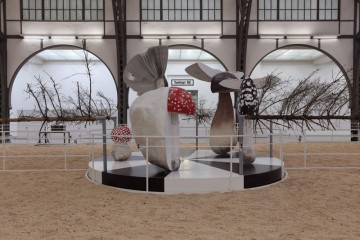
Carsten Höller, "Soma," 2010. Installation view, Hamburger Bahnhof – Museum für Gegenwart – Berlin, 2010, © VG Bild-Kunst 2010 / Carsten Höller. Photo: Attilio Maranzano.
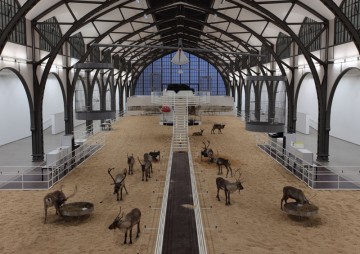
Carsten Höller, "Soma," 2010. Installation view, Hamburger Bahnhof – Museum für Gegenwart – Berlin, 2010, © VG Bild-Kunst 2010 / Carsten Höller. Photo: Attilio Maranzano.
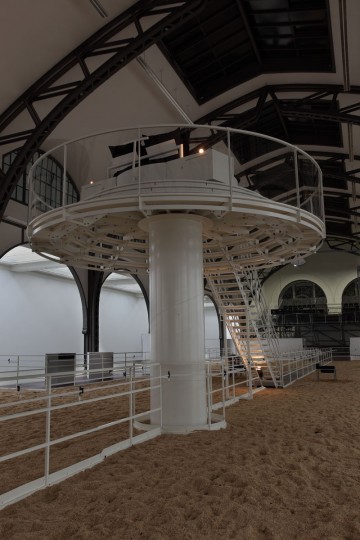
Carsten Höller, "Soma," 2010. Installation view, Hamburger Bahnhof – Museum für Gegenwart – Berlin, 2010, © VG Bild-Kunst 2010 / Carsten Höller. Photo: Attilio Maranzano
Functioning as a three-dimensional tableau vivant, the exhibition space can be viewed from a tribune. Central to this set (and I can’t wait to see this part) is supposedly a mushroom-shaped platform that holds a hotel room which can actually be booked for one night at a time! I am sure tickets will go fast, but this might be the perfect Christmas gift for the person who has everything — except for the chance to spend a night at a museum surrounded by live reindeer, sleeping on a giant mushroom. Check here for more information.
If you’re looking for a day trip on a beautiful fall day, a great place to venture out to is the Haus am Waldsee, nestled into the forest near the shore of Schlachtensee lake in the south of Berlin. Inside, works by German painter Frank Nitsche are on display until November 14th, and surrounding the 1920s-build villa there is a sculpture garden.

Copyright: Haus am Waldsee.
Visitors are also invited to undertake a “bicycle tour of modernism,” an audio tour that takes cyclists by some of the prominent villas around Schlachtensee lake. Hermann Muthesius’s famous house van Velsen, built in 1907, Werner Aisslinger’s Loftcube of 2004 in the park at Haus am Waldsee, and buildings by architects like Ludwig Mies van der Rohe and Walter Gropius are part of the tour. You can either byob or rent bikes at the Haus am Waldsee for €5 for 2 hrs.
Even though it arguably does not has its place in a Berlin column as it does not strictly deal with a Berlin art event, an important press conference took place this week in Kreuzberg, which I feel should have its mention here as well (at least until the city of Kassel gets its own Art21 column).
Last Friday, October 29, Carolyn Christov-Bakargiev, curator of dOCUMENTA 13, announced and introduced the event’s curatorial team at Berlin’s Hebbel Theater.
Christov-Bakargiev, who describes dOCUMENTA13’s curatorial approach as not following a single, overall concept but rather the bringing together of materials, methods, and forms of knowledge from a variety of disciplines, has formed a team consisting of “advisors” and “agents” that she will be working with for the next 2 years. The “agents” are made up of 15 curators, artists, and art critics, amongst them Afghanistan-born, NY-based independent curator Leeza Ahmady, the director of NY’s annual Asian Contemporary Art Week; Korean curator and professor, Sunjung Kim; and Hetti Perkins, senior curator of Aboriginal and Torres Strait Islander Art at the Art Gallery of New South Wales in Sydney, Australia. Notably, 12 of the 15 agents are women.
The members of the honorary advisory committee are made up of such diverse individuals as the Mexico-city-born writer, Mario Bellatin; Ali Brivanlou, Professor of Laboratory of Molecular Vertebrate Embryology at Rockefeller University; conservator, historian, and archeologist, Michael Petzet; Michael Taussig, professor of anthropology at Columbia University; and Donna Haraway, Professor in the History of Consciousness Department at the University of California at Santa Cruz.
These “agents” and “advisors” will be involved in shaping the 100-day exhibition of dOCUMENTA 13 in the summer of 2012, as well as a number of artistic acts and gestures preceding the event. Their diversity, paired with the ominous “reading list” of 9 pages and almost 200 titles that was handed out to journalists at Hebbel Theater, lets one anticipate an interesting, theory-based and yet multi-layered experience of dOCUMENTA 13 that no doubt will have relevance for Berlin as a stage for side events and many of its artists.

